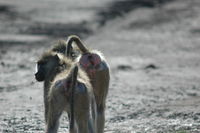 The exaggerated estrous swelling displayed by females of many Old World primates has often been thought of as a trait that functions as a reliable indicator of individual female quality. Indeed, baboon swellings are regularly held up as the text-book example. This idea is based on Pagel (1994), which put forward the Reliable Indicator Hypothesis. This hypothesis posited that the exaggerated swellings of some females are consistently larger than others (i.e. inter-individual variation in size), that this swelling size is an indicator of heritable female ‘quality’ (quality that translates into variation in lifetime reproductive success), and that males therefore prefer those females that have larger swellings. Previous work in the Amboseli baboons provided support for the first part of the reliable indicator hypothesis; swellings of some females are indeed larger than others (Fitzpatrick et al. 2014). However, until the recent study by Amboseli researchers, a complete test of the Reliable Indicator Hypothesis had not been conducted in any primate population. In order to conduct this test, two predictions were examined. The first prediction is that females with larger swellings will be preferred by males and the second prediction is that females with larger swellings will exhibit higher reproductive success. After analyzing morphological and behavioral data collected over 1.5 years of field-work, in combination with the longitudinal data on births and infant survival, the researchers found no support for the Reliable Indicator Hypothesis. Specifically, there was only mixed evidence that males bias their matting effort toward females with larger swellings. In contrast, there was strong evidence that males do prefer those females who had experienced more sexual cycles since their most recent pregnancy. Furthermore, the researchers found a marked absence of evidence that females with larger swellings produced more offspring or offspring with higher survival rates. Thus, the only complete test of the reliable indicator hypothesis in the field rejects it. The finding that males prefer females who have experienced more cycles points to an important distinction between the quality of an individual female and the quality of a reproductive opportunity. This study indicates that, from the perspective of male baboons, the former has more important consequences than the latter.
The exaggerated estrous swelling displayed by females of many Old World primates has often been thought of as a trait that functions as a reliable indicator of individual female quality. Indeed, baboon swellings are regularly held up as the text-book example. This idea is based on Pagel (1994), which put forward the Reliable Indicator Hypothesis. This hypothesis posited that the exaggerated swellings of some females are consistently larger than others (i.e. inter-individual variation in size), that this swelling size is an indicator of heritable female ‘quality’ (quality that translates into variation in lifetime reproductive success), and that males therefore prefer those females that have larger swellings. Previous work in the Amboseli baboons provided support for the first part of the reliable indicator hypothesis; swellings of some females are indeed larger than others (Fitzpatrick et al. 2014). However, until the recent study by Amboseli researchers, a complete test of the Reliable Indicator Hypothesis had not been conducted in any primate population. In order to conduct this test, two predictions were examined. The first prediction is that females with larger swellings will be preferred by males and the second prediction is that females with larger swellings will exhibit higher reproductive success. After analyzing morphological and behavioral data collected over 1.5 years of field-work, in combination with the longitudinal data on births and infant survival, the researchers found no support for the Reliable Indicator Hypothesis. Specifically, there was only mixed evidence that males bias their matting effort toward females with larger swellings. In contrast, there was strong evidence that males do prefer those females who had experienced more sexual cycles since their most recent pregnancy. Furthermore, the researchers found a marked absence of evidence that females with larger swellings produced more offspring or offspring with higher survival rates. Thus, the only complete test of the reliable indicator hypothesis in the field rejects it. The finding that males prefer females who have experienced more cycles points to an important distinction between the quality of an individual female and the quality of a reproductive opportunity. This study indicates that, from the perspective of male baboons, the former has more important consequences than the latter.
